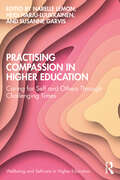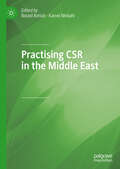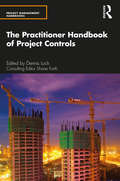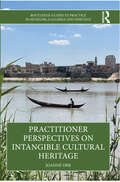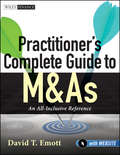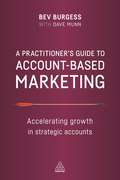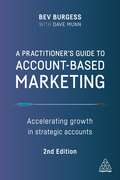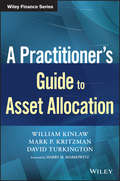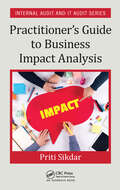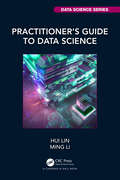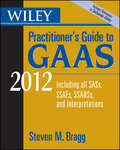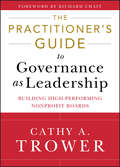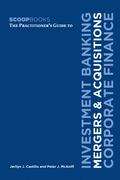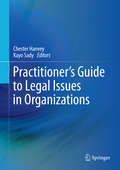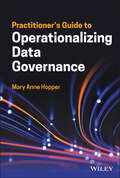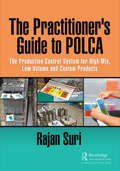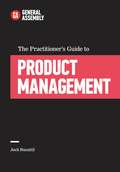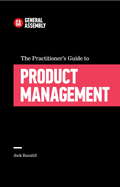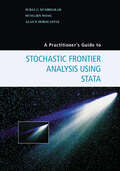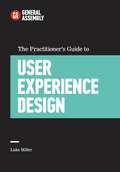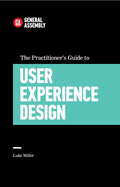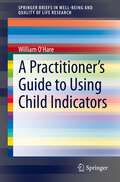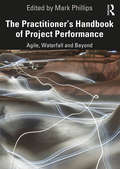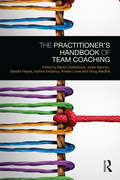- Table View
- List View
Practising Compassion in Higher Education: Caring for Self and Others Through Challenging Times (Wellbeing and Self-care in Higher Education)
by Narelle Lemon Heidi Harju-Luukkainen Susanne GarvisPresenting a collective international story, this book demonstrates the importance of compassion as an act of self-care in the face of change and disruption, providing guidance on how to cope under trying conditions in higher education settings. Practising Compassion in Higher Education presents an opportunity to learn through story and by taking proactive action for our wellbeing. It highlights the need to protect and maintain the wellbeing of staff and students, positioning the COVID-19 pandemic as a major catalyst of disruption. The chapters connect theory with lived experience, exploring self-compassion in work and research, compassion in teaching practice and within the personal/professional blur. The book’s contributors bring a range of theoretical and personal perspectives from various global contexts, sharing their own approaches to self-care and how compassion has become a central and crucial element of this practice. This book takes a unique approach to navigating and surviving the higher education environment and offers valuable lessons for the pandemic era and beyond. This will be an essential resource for students and professionals working in all areas of higher education.
Practising CSR in the Middle East
by Belaid Rettab Kamel MellahiEdited by two renowned specialists in CSR in the Middle East, this book features contributions from leading CSR scholars in the region. Each chapter provides a comprehensive and up-to-date discussion of the most pertinent issues within the subject area, and also includes a number of real life case studies addressing emerging and timely CSR topics facing organizations in the Middle East. The book is intended for researchers and students of CSR, providing a state-of-the-art overview of the key themes, best practices and current debates focused upon the Middle East.
The Practitioner Handbook of Project Controls (Project and Programme Management Practitioner Handbooks)
by Dennis LockAlthough projects always carry risk, too many projects run late or exceed their original budgets by eye-watering amounts. This book is a comprehensive guide to the procedures needed to ensure that projects will be delivered on time, to specification and within budget. Eight expert contributors have combined their considerable talents to explain all aspects of project control from project conception to completion in an informative text, liberally supported where necessary by clear illustrations. This handbook will benefit all project practitioners, including project managers and those working in project management offices. It will also provide an invaluable guide for students studying for higher degrees in project management and its associated disciplines.
Practitioner Perspectives on Intangible Cultural Heritage (Routledge Guides to Practice in Museums, Galleries and Heritage)
by Joanne OrrPractitioner Perspectives on Intangible Cultural Heritage provides an accessible introduction to the Intangible Cultural Heritage field. Summarising the major changes that have taken place over the last two decades, the book explores ongoing debates and changes in thinking about best practice. Drawing on the author’s own experience of operationalising the UNESCO 2003 Convention for the Safeguarding of Intangible Cultural Heritage in a variety of contexts, Orr also incorporates international case studies from practitioners and provides valuable insights about best practices. Demonstrating that the top-down, state-driven hierarchy for the safeguarding of heritage is starting to shift to a model of shared ownership and values driven by communities and practitioners, the book shows that the notion of the ‘expert’ is also diversifying to include other forms of transmission of traditional knowledge. Orr argues that these different perspectives provide a platform to enrich understanding and knowledge and create a stronger basis for the safeguarding of heritage - both intangible and tangible. Exploring some of the policy developments that have laid the foundations for the future involvement of community and practitioners in the global discourse, the book also suggests how practitioners can expand networks and contribute to the global discourse. Practitioner Perspectives on Intangible Cultural Heritage will appeal to museum curators and other heritage professionals, as well as students and academics engaged in the study of museums and heritage, art, and cultural policy and management.
Practitioner's Complete Guide to M&As
by David T. EmottThe ultimate guide to the ins and out of mergers and acquisitionsPractitioner's Complete Guide to M&As provides the practical tricks of the trade on M&As: what they need to know, what they have to know, and what they need to do. Numerous examples and forms are included illustrating concepts in discussion.Written in a straight-talking styleA highly, practical application-oriented guide to mergers and acquisitionsCovers strategy development; deal flow and target identification; due diligence; valuation and offers; tax structuring; negotiation; and integration and value creation"Presents information using bullet points rather than lengthy narrative for ease of readingNumerous exhibits, forms, and examples are includedThis practical guide takes you through every step of the M&A process, providing all the necessary tools that both the first-time M&A player as well as the seasoned practitioner need to complete a smart transaction.
A Practitioner's Guide to Account-Based Marketing: Accelerating Growth in Strategic Accounts
by Bev Burgess Dave MunnAccount-based marketing, also known as client-centric marketing, is in the process of transforming modern marketing practice. It involves taking a strategic approach to business to business marketing, whereby important individual accounts are treated as markets in their own right. After all, many of the world's leading companies have annual revenues the size of some countries' GDP, so for the businesses that provide services and solutions to these companies, such key accounts truly do represent a global market. A Practitioner's Guide to Account-Based Marketing explores the development of account-based marketing (ABM) as a business practice, and outlines a clear, step-by-step process for readers who wish to set up an ABM programme to accelerate growth. Rich with fascinating case studies and personal stories, A Practitioner's Guide to Account-Based Marketing offers readers privileged access to lessons learned by pioneering companies in the field, including BT, Fujitsu, IBM, Juniper Networks, Microsoft, SAP, and many more. The text is fully endorsed by the Information Technology Services Marketing Association (ITSMA), who run the only formally recognized qualification in the sector: the Account-Based Marketing Certification Programme. Meticulously researched and highly practical, A Practitioner's Guide to Account-Based Marketing will help all marketers strengthen relationships, build reputation, and increase revenues in their most important accounts.
A Practitioner's Guide to Account-Based Marketing: Accelerating Growth in Strategic Accounts
by Bev Burgess Dave MunnAs some of today's major and complex companies are worth more than the GDPs of some countries, traditional marketing approaches, such as glossy corporate campaigns, will have limited returns. Account-based marketing, also known as client-centric marketing, treats important individual accounts as markets in their own right, to help strengthen relationships, build reputation, and increase revenues in important accounts.A Practitioner's Guide to Account-Based Marketing outlines a clear, step-by-step process for readers to harness ABM tools and techniques and set up ABM programmes. Featuring insights from practising professionals and case studies from organizations including Microsoft, Accenture, O2 and Fujitsu, it also contains guidance on developing the competencies needed for account-based marketing and managing your ABM career. This updated second edition contains further discussion on how ABM initiatives can go from a pilot to being embedded in a business, new material on quantified value propositions and updated wider research. Meticulously researched and highly practical, A Practitioner's Guide to Account-Based Marketing will help all marketers to deliver successful B2B marketing.
A Practitioner's Guide to Asset Allocation
by David Turkington Harry M. Markowitz Mark P. Kritzman William KinlawThe authors' goal in writing this book is twofold: to describe several important innovations that address key challenges to asset allocation and to dispel certain fallacies about asset allocation. Section I covers the fundamentals of asset allocation, section II presents certain fallacies about asset allocation which the authors attempt to dispel either by logic or with evidence, section III discusses recent innovations, and section IV provides supplementary material.
Practitioner's Guide to Business Impact Analysis (Security, Audit and Leadership Series)
by Priti SikdarThis book illustrates the importance of business impact analysis, which covers risk assessment, and moves towards better understanding of the business environment, industry specific compliance, legal and regulatory landscape and the need for business continuity. The book provides charts, checklists and flow diagrams that give the roadmap to collect, collate and analyze data, and give enterprise management the entire mapping for controls that comprehensively covers all compliance that the enterprise is subject to have. The book helps professionals build a control framework tailored for an enterprise that covers best practices and relevant standards applicable to the enterprise. Presents a practical approach to assessing security, performance and business continuity needs of the enterprise Helps readers understand common objectives for audit, compliance, internal/external audit and assurance. Demonstrates how to build a customized controls framework that fulfills common audit criteria, business resilience needs and internal monitoring for effectiveness of controls Presents an Integrated Audit approach to fulfill all compliance requirements
Practitioner’s Guide to Data Science (Chapman & Hall/CRC Data Science Series)
by Hui Lin Ming LiThis book aims to increase the visibility of data science in real-world, which differs from what you learn from a typical textbook. Many aspects of day-to-day data science work are almost absent from conventional statistics, machine learning, and data science curriculum. Yet these activities account for a considerable share of the time and effort for data professionals in the industry. Based on industry experience, this book outlines real-world scenarios and discusses pitfalls that data science practitioners should avoid. It also covers the big data cloud platform and the art of data science, such as soft skills. The authors use R as the primary tool and provide code for both R and Python. This book is for readers who want to explore possible career paths and eventually become data scientists. This book comprehensively introduces various data science fields, soft and programming skills in data science projects, and potential career paths. Traditional data-related practitioners such as statisticians, business analysts, and data analysts will find this book helpful in expanding their skills for future data science careers. Undergraduate and graduate students from analytics-related areas will find this book beneficial to learn real-world data science applications. Non-mathematical readers will appreciate the reproducibility of the companion R and python codes. Key Features: • It covers both technical and soft skills. • It has a chapter dedicated to the big data cloud environment. For industry applications, the practice of data science is often in such an environment. • It is hands-on. We provide the data and repeatable R and Python code in notebooks. Readers can repeat the analysis in the book using the data and code provided. We also suggest that readers modify the notebook to perform analyses with their data and problems, if possible. The best way to learn data science is to do it!
Practitioner's Guide to GAAS 2012
by Steven M. BraggThe clearest, easiest-to-use guide to understanding GAAS 2012 on the market--fully updated This latest resource to understanding GAAS addresses the toughest part of the job--identifying, interpreting, and applying the many audit, attest, review, and compilation standards relevant to a particular engagement. The only GAAS reference organized according to practitioners' actual use of the Statements on Auditing Standards (SASs), inside you'll find examples and illustrations for testing internal controls, techniques for remaining compliant with each standard, and explanations of the reasons for each pronouncement. A brief identification of each SAS, SSAE, and SSARS, with its effective date and tips on when to apply it A convenient and comprehensive glossary of official definitions, which are usually scattered throughout a standard Behind-the-scenes explanations of the reasons for each pronouncement and brief explanations of the basic ideas of the section Concise listing and descriptions of each standard's specific mandate Easy-to-read capsule summary of interpretations, plus selected AICPA practice alerts and advisories Helpful techniques for remaining compliant with each standard Examples and illustrations for testing internal controls Wiley Practitioner's Guide to GAAS 2012 presents each statement individually, explaining how the standards are related and offering guidance on the entire engagement process in the form of practice notes, checklists, questionnaires, and real-world examples that illustrate how the fundamental requirements of each section are applied.
The Practitioner's Guide to Governance as Leadership
by Cathy A. TrowerPraise for The Practitioner's Guide to Governance as Leadership"With wisdom and insight, Trower has written the seminal guide for nonprofit boards. This is a must-read for every current and incoming nonprofit board member."--Joel Allison, president and CEO, Baylor Health Care System"For nonprofit chief executives who are ready for more engaged and purposeful boards and for board members who want to work more meaningfully and be true partners in leadership, Trower shows the way. She brings Governance as Leadership to life with case studies, theoretical frameworks, board exercises, and practical advice."--Susan Whealler Johnston, executive vice president, Association of Governing Boards of Universities and Colleges (AGB)"It has never been more critical than it is today for nonprofits to engage their boards in ways that capture the full talent, experience and resources of those who govern the work.?Yet, too often, we see organizations facing a substantial board-engagement gap.?In this book, Trower shares the pathway forward for nonprofit and philanthropic leaders seeking to transform their boards in ways that will have an exponential impact on everything from strategy to fundraising. I've learned much from Trower's work on board leadership over the years--I'm thrilled she's now sharing it broadly through this valuable new resource for our sector."--Robert B. Acton, executive director NY, Taproot Foundation"At BoardSource, we value Governance as Leadership as a groundbreaking publication that has helped thousands of board leaders view governance in a new way. With this new book, Trower has taken on the important task of connecting the dots back to the boardroom, where nonprofits of all sizes are struggling with leading their organizations through these challenging times ... she deftly combines business, psychological, and sociological principles to help board members examine their own thought processes and raise the level of thinking and discourse in the boardroom."--Linda C. Crompton, president and CEO, BoardSource
The Practitioner's Guide To Investment Banking, Mergers And Acquisitions, Corporate Finance (Scoopbooks)
by Jerilyn Castillo Peter McAniffTHE PRACTITIONERS GUIDE provides a thorough grounding in mergers & acquisitions and corporate finance for those who want to know more about the world of investment banking. A practical handbook, THE PRACTITIONERS GUIDE presents comprehensive explanations of the analytical processes used to evaluate and structure mergers, acquisitions, divestitures, and capital raising transactions. Finance professionals, corporate attorneys, accountants, corporate development teams and MBAs will find THE PRACTITIONERS GUIDE essential as a resource and desktop companion.
Practitioner's Guide to Legal Issues in Organizations
by Chester Hanvey Kayo SadyThis highly useful reference outlines best practices in key areas of human resources that are not only fair and equitable, but that can withstand legal scrutiny. Industrial/organizational experts apply their empirical knowledge and practical experience to aspects of HR that are commonly litigated, including broad and specific topics in testing of potential employees, disability issues, compensation and pay equity, and work hours. The book is written to be accessible to readers currently in HR-related graduate-level training as well as HR practitioners with or without background in industrial/organizational psychology. And to add to its utility, chapters feature practical strategies for addressing each of the legal issues presented. Among the topics covered: Measuring adverse impact in employee selection decisions. Using background checks in the employee selection process. Disabilities: best practices for vulnerabilities associated with the ADA. Physical abilities testing. Wage and hour litigation. Clinical psychological testing for employee selection. Conducting compensation equity analyses. Practitioner's Guide to Legal Issues in Organizations brings clear, up-to-date information to graduate students studying human resources, management, industrial/organizational psychology who are interested in legal issues, as well as applied HR practitioners such as industrial/organizational psychologists, human resources generalists, management and labor economists.
Practitioner's Guide to Operationalizing Data Governance (Wiley and SAS Business Series)
by Mary Anne HopperDiscover what does—and doesn’t—work when designing and building a data governance program In A Practitioner’s Guide to Operationalizing Data Governance, veteran SAS and data management expert Mary Anne Hopper walks readers through the planning, design, operationalization, and maintenance of an effective data governance program. She explores the most common challenges organizations face during and after program development and offers sound, hands-on advice to meet tackle those problems head-on. Ideal for companies trying to resolve a wide variety of issues around data governance, this book: Offers a straightforward starting point for companies just beginning to think about data governance Provides solutions when company employees and leaders don’t—for whatever reason—trust the data the company has Suggests proven strategies for getting a data governance program that’s gone off the rails back on trackComplete with visual examples based in real-world case studies, A Practitioner’s Guide to Operationalizing Data Governance will earn a place in the libraries of information technology executives and managers, data professionals, and project managers seeking a one-stop resource to help them deliver practical data governance solutions.
The Practitioner's Guide to POLCA: The Production Control System for High-Mix, Low-Volume and Custom Products
by Rajan SuriPOLCA (Paired-cell Overlapping Loops of Cards with Authorization) is a card-based visual control system that manages the flow of jobs through the shop floor: at each operation, it controls which job should be worked on next to meet delivery targets. POLCA ensures that upstream operations use their capacity effectively by working on jobs that are needed downstream, while at the same time preventing excessive work-in-process (WIP) build-ups when bottlenecks appear unexpectedly. POLCA is particularly suited to companies manufacturing high-mix, low-volume and customized products. Such companies struggle with long lead times, late deliveries, and daily expediting to meet delivery dates. ERP systems are not designed to deal with this highly variable environment, and add-on software such as Finite Capacity Scheduling systems can require complex installation. Also, the Kanban system does not work well with low-volume or custom production. POLCA has delivered impressive results in such environments. It does not require any complex software implementation: it can be used without an ERP system or it can seamlessly complement an existing ERP system. This book: Provides a step-by-step roadmap on how to implement POLCA; invaluable for both companies that wish to implement POLCA as well as consultants and academics advising such companies. Explains the concepts in practical and easy-to-understand terms by showing detailed shop-floor examples. Includes more than 100 illustrations for understanding how POLCA works as well as for elaborating on details of the implementation steps. Contains case studies written by company owners and executives documenting their POLCA implementation process and the results achieved in various industries in six countries.
The Practitioner's Guide to Product Management
by General Assembly Jock BusuttilDid you cut through traffic on your Segway today? Cool off with a delicious can of New Coke? Relax at home while listening to some music on your Zune?Despite years of research, countless products like these see high-profile launches, only to end up failing to connect with an audience. THE PRACTITIONER'S GUIDE TO PRODUCT MANAGEMENT provides a firsthand road map to help you avoid the pitfalls of product failure-taking you through the field of product management with candid stories and real-world experiences of what it takes to create a product that meets the customer's needs.
The Practitioner's Guide To Product Management
by Jock BusuttilProduct management has never been a more necessary or in-demand discipline for both technology startups and more established companies. Through technology, we have the means to enrich our work and leisure time in ways people, even just a few years ago, could only have dreamed about. It is easier, cheaper and quicker than it ever has been before to create technology products in both software and hardware. Everything is continually changing and the pace of innovation is perpetually increasing - just look at 3D printing.Product management is the art, science and skill of bringing a successful product to life. In The Practitioner's Guide To Product Management, Jock Busuttil looks what product managers do, how the role came to be, how it's still continuing to evolve, and why it's such good news that there's no prescribed route to becoming one. Busuttil also delves into examples of the good, the bad and the ill-advised products to consider why they succeeded and failed and give you the inside track on avoiding all the common product management pitfalls. The book examines the fine line between success and failure and reveals nine ways you can increase your product's chances of success.If you're new to product management and wondering what it's all about or if you're a product manager shooting for professional success, this book will give you the inside track on starting, developing, and then selling a new product.
A Practitioner's Guide to Stochastic Frontier Analysis Using Stata
by Subal C. Kumbhakar Hung-Jen Wang Alan P. HorncastleStochastic Frontier Analysis Using Stata provides practitioners in academia and industry with a step-by-step guide on how to conduct efficiency analysis using the stochastic frontier approach. The authors explain in detail how to estimate production, cost, and profit efficiency and introduce the basic theory of each model in an accessible way, using empirical examples that demonstrate the interpretation and application of models. This book also provides computer code, allowing users to apply the models in their own work, and incorporates the most recent stochastic frontier models developed in academic literature. Such recent developments include models of heteroscedasticity and exogenous determinants of inefficiency, scaling models, panel models with time-varying inefficiency, growth models, and panel models that separate firm effects and persistent and transient inefficiency. Immensely helpful to applied researchers, this book bridges the chasm between theory and practice, expanding the range of applications in which production frontier analysis may be implemented.
The Practitioner's Guide to User Experience Design
by General Assembly Luke MillerSell a hamburger. Run an airline. Build a website.No matter how simple or complicated your business is, there's one thing that determines if it's a success or not: the customer.THE PRACTITIONER'S GUIDE TO USER EXPERIENCE breaks down the essence of what it takes to meet a customer's needs and shows you how to apply these principles while working in tech. From finding your inspiration to creating prototypes, this book pulls from case studies, research, and personal experience to give you the tools and tactics you need to survive in the fast-paced world of UX design.
The Practitioner's Guide To User Experience Design
by Luke MillerThe core mission of User Experience (UX) design is to craft digital experiences that not only empower but delight users, and we've never had a better set of tools for doing so. Not only is there strong demand in digital product development for people with UX skills, but technology is evolving so rapidly and in such interesting ways that the work affords constant opportunities to innovate and let your creativity run. But how do you get into UX Design? Do you have to know how to write code? Or do you need a degree in design? And what exactly is UX? Does it refer to the process or the result? In The Practitioner's Guide To User Experience Luke Miller answers all of these questions and draws on his own experience and examples of specific projects to walk you through the methods used by designers to craft user experiences. These include:*Techniques of user research, including conducting user interviews and surveys and creating personas to represent the range of users you're appealing to, as well as performing competitive analysis of rival products. *A core set of methods for crafting well designed routes of navigation through sites and apps, called user flows *Creating the layouts and designing the interface elements of pages, from initial sketching and creating a rough site map, through the drawing of more detailed page designs, generally called wireframes, and on to making moving prototypes. *User testing - everything from rough sketches to fully functioning prototypes to interpreting the results of tests and making recommendations for any changes to products. The best UX comes from learning by doing and understanding how creative, fun and satisfying the work can be. Adding UX expertise to your mix of skills will make you more marketable, a knowledge of UX principles and practices and will enrich your work in any part of digital product creation.
A Practitioner’s Guide to Using Child Indicators (SpringerBriefs in Well-Being and Quality of Life Research)
by William O'HareThis book focuses on projects using child indicators outside of a research context and provides a user-friendly set of materials to help professionals or organizations start and sustain high-quality child indicator projects. The book is based on the fundamental idea that better data leads to better decisions regarding programs for children. The number of people with experience and expertise in developing child indicator projects is limited in many countries. This initiative provides critical information on the topic in a cost-effective manner, and thereby fills an important niche regarding the use of child indicators. To the extent that it promotes more and better child indicator projects, the book leads to more attention for children and better decision-making regarding public support for children. It is also likely to increase the number of such projects that exist and to improve the quality of such projects. This easy-to-use and practical guide is for all professionals and organizations working with child indicators data.
The Practitioner's Handbook of Project Performance: Agile, Waterfall and Beyond
by Mark PhillipsPractitioners operate in a necessary reality. We work in a space where project performance is above theory or methodology. In the best environments, delivery and an affirmative culture are what matter most. In the worst, it is politics and survival. In any environment we are challenged to adopt best practices and adapt our style to the environment in which the project is occurring. This is a book about those best practices and practitioner experiences. It is a must have reference and guide book for project managers, general managers, business leaders and project management researchers. This book is the result of the hard work and dedication of more than 35 authors from more than 15 countries across four continents. It brings a diversity of experience, professional and personal. It includes practitioners, leading academics, renowned theorists and many who straddle those roles. The chapters cover experiences in software, large scale infrastructure projects, finance and health care, to name a few. The chapters themselves take many forms. Check out the table of contents to get a deeper sense of the topics included. All provide real-world guidance on delivering high performing projects and show you how to build, lead and manage high performing teams. The Practitioners Handbook of Project Performance is complete in itself. It can also be an enticing start to an ongoing dialogue with the authors and a pleasurable path to get deeper into the subject of project performance. Find your favorite place to begin learning from these chapters, to begin taking notes and taking away nuggets to use in your everyday. But don’t stop there. Contact information and further resources for this diverse team of experts authors are found throughout. The Practitioners Handbook is a modern guide to the leading edge of project performance management and a path to the future of project delivery.
The Practitioner’s Handbook of Team Coaching
by David Clutterbuck Ioanna Iordanou Judie Gannon Sandra Hayes Krister Lowe Doug MacKieThe world’s challenges are becoming more and more complex and adapting to those challenges will increasingly come from teams of people innovating together. The Practitioner’s Handbook of Team Coaching provides a dedicated and systematic guide to some of the most fundamental issues concerning the practice of team coaching. It seeks to enhance practice through illustrating and exploring an array of contextual issues and complexities entrenched in it. The aim of the volume is to provide a comprehensive overview of the field and, furthermore, to enhance the understanding and practice of team coaching. To do so, the editorial team presents, synthesizes and integrates relevant theories, research and practices that comprise and undergird team coaching. This book is, therefore, an invaluable specialist tool for team coaches of all levels; from novice to seasoned practitioners. With team coaching assuming an even more prominent place in institutional and organizational contexts nowadays, the book is bound to become an indispensable resource for any coaching training course, as well as a continuing professional development tool. This book is essential reading for anyone with an interest in coaching, in both practice and educational settings. It will be of use not only for professional coaches, but also for leaders, managers, HR professionals, learners and educators, in the business, public, independent and voluntary sectors.
PraDigi Open Learning: Transforming Rural India
by John J-H Kim Malini SenPratham is a non-governmental organization, focusing on high-quality, low-cost and replicable interventions to address gaps in the Indian education system. Co-founder Madhav Chavan is interested in using technology for education but differed in the way it is used in schools in India. He believes that technology allowed flexibility and non-linearity in exploring knowledge while the school classroom is based on a rigid and linear path of learning textbook lessons for the sake of examinations. Keeping this in mind, Chavan designs a digital initiative, PraDigi Open Learning, to improve basic numeracy and literacy skills among children in rural India. Electronic tablets pre-loaded with content is distributed in a few villages to help increase children's engagement with learning. Self-directed peer group learning is encouraged. The tablets trigger the children's curiosity. Post-COVID 19, when children are not able to attend class because of the lockdown, Chavan wonders how PraDigi Open Learning can be scaled and aligned with school education to ensure uninterrupted learning.
